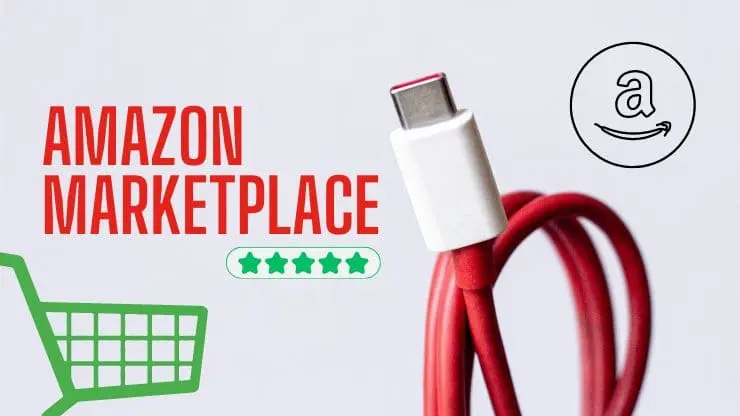The geography ofe-commerce has experienced a seismic shift since the commencement of Amazon Marketplace. Formed in the gauntlet of 2000, Amazon Marketplace has evolved into a dynamic drive, furnishing merchandisers with unknown openings and offering consumers a flawless shopping visit.
Definition and Evolution
Let’s examine the relationship between “Definition” and “Evolution” and the Amazon Marketplace:
Definition:
The Amazon Commercial Center alludes to the internet-based stage given by Amazon, where outsider dealers can rundown and sell their items straightforwardly to shoppers. An immense Internet business environment permits organizations of different sizes to contact a worldwide crowd. Dealers can make item postings, oversee stock, and satisfy orders through the Amazon Commercial Center.
Key elements of the Amazon Commercial Center incorporate item pages, client surveys, satisfaction choices (like Satisfaction by Amazon, FBA), and a powerful hunt and suggestion framework. Amazon goes about as both a facilitator and a contender, as it likewise sells its own items close to those of outsider merchants.
Evolution:
The Amazon Commercial Center has developed fundamentally since its commencement. Here are a few vital parts of its development:
Innovation and Framework: In order to handle the increasing volume of transactions, Amazon has continuously invested in upgrading its technological infrastructure. This includes enhancements to server capacity, machine learning algorithms, and data analytics that underpin the functions of product recommendations and search.
Extension of Item Classifications: Throughout the long term, Amazon has extended the scope of items accessible on its foundation. It started with books and now includes almost every kind of product, from clothes and electronics to groceries and digital services.
Global Reach: Amazon has extended its presence universally, permitting merchants from different nations to partake in the Commercial Center. This globalization has made it workable for dealers to enter new business sectors and given customers admittance to a large number of items.
Satisfaction Administrations: The presentation of Satisfaction By Amazon (FBA) has been a unique advantage. Dealers can pick to have Amazon store, pack, and boat their items, which can improve conveyance speed and consumer loyalty.
Strategy and Guideline Changes: Amazon has carried out different strategy changes over the long run to upgrade the client experience and keep up with the honesty of the Commercial Center. This incorporates strategies connected with item quality, client criticism, and dealer execution measurements.
Acquisitions and Organizations: Amazon has extended its reach through acquisitions and organizations. For instance, the obtaining of the entire food sources market permitted Amazon to enter the staple market, and associations with outsider conveyance administrations have worked on the speed and effectiveness of item conveyances.
Historical Overview of Amazon Marketplace
A. Amazon Marketplace’s History:
The Amazon Commercial Center had its starting point in the vision of Jeff Bezos, who established Amazon.com in July 1994. At first, Amazon began as a web-based book shop, yet Bezos had a more fabulous vision of making an “everything store” where clients could find and buy any item on the web. When Amazon invited third-party sellers to join the platform in 2000, the transition to a more diverse marketplace began.
Independent sellers were able to list their products alongside those sold directly by Amazon thanks to the launch of the Amazon Marketplace. This noticeable change in the organization’s plan of action empowers it to extend its item list dramatically without the need to possess all the stock genuinely. This move likewise democratized online business, furnishing little and medium-sized organizations with a worldwide stage to arrive at clients.
B. Achievements and Development:
Mid 2000s: Outsider Merchant Mix:
The mid 2000s saw the joining of outsider venders into the Amazon stage. As it transformed Amazon from a retailer that sold its own inventory to a platform that connected buyers and sellers worldwide, this was a significant turning point.
2002: Presentation of Amazon Web Administrations (AWS):
While not straightforwardly connected with the Commercial Center, the presentation of AWS in 2002 assumed a crucial part in Amazon’s general development. AWS made a lot of money by offering cloud computing services and supporting the technological infrastructure that would later be beneficial to the Marketplace.
2006: The Launch of Fulfillment by Amazon (FBA):
FBA was a distinct advantage. Dealers could pick to have Amazon store, pack, and boat their items, utilizing Amazon’s broad satisfaction organization. This smoothed out the coordinated factors for venders as well as further developed transportation times and consumer loyalty.
In 2009, Zappos was bought:
The essential extension of Amazon into new item classifications was exhibited by the organization’s securing of Zappos, a web-based shoe and apparel retailer. This acquisition was important for Amazon’s more extensive endeavors to broaden its item contributions and harden its situation as the “everything store.”
2015: Send off Amazon Prime Day:
Prime Day has developed into a yearly occasion that offers Amazon Prime individuals restrictive arrangements since its beginning in 2015. It not just prompted an expansion in that frame of mind of Prime Individuals but additionally in deals, further laying out Amazon as a central part in online business.
2017: Procurement of Entire Food Varieties Market:
The obtaining of entire food varieties flagged Amazon’s entrance into the physical staple area. The company’s determination to expand and integrate online and offline retail experiences was demonstrated by this move.
2020: Flood in Online Business In the midst of a Worldwide Pandemic:
The Coronavirus pandemic prompted an expansion in web based shopping and an exceptional interest for Amazon items. The organization needed to adjust to expanded volumes, carry out wellbeing estimates in its satisfaction habitats, and recruit extra staff to satisfy the developing need for web-based business.
These achievements and snapshots of development feature the unique advancement of the Amazon Commercial Center. From its unassuming starting points as a web-based book shop to turning into a worldwide online business monster with different item classes, vital acquisitions, and mechanical developments, Amazon’s process has been set apart by ceaseless variation and extension.
Amazon Marketplace Structure
A. Dealer Focal versus Seller Focal:
Vender Focal:
Outsider Venders: Vender Focal is basically intended for outsider merchants who list their items on the Amazon Commercial Center. These merchants deal with their own stock, set costs, and handle delivering.
Command Over Postings: Venders utilizing Dealer Focal have more command over their item postings, including item depictions, pictures, and estimating. They can likewise get to instruments to streamline their postings and advance their items.
Direct Collaboration With Clients: Customers in Seller Central can talk to sellers directly about things like customer service, handling returns, and responding to feedback.
Expenses Construction: Dealers on Merchant Focal Compensation have different expenses, including reference charges and, in the event that they decide, satisfaction charges. Costs associated with shipping and customer service fall on them.
Supplier Central:
First-Party Merchants (1P): First-party sellers, or 1P sellers, are the focus of Vendor Central. In this model, Amazon buys items straightforwardly from the merchant and sells them on the stage. Manufacturers, distributors, or other organizations may serve as vendors.
Restricted Command Over Postings: Because Amazon sets prices and manages inventory, vendors have less control over their product listings. Amazon may likewise assume responsibility for advertising and special exercises.
Mass Requesting: Products are typically purchased in bulk by vendors from Amazon, and Amazon handles fulfillment and shipping. This model is more similar to customary discount connections.
Support For Vendors: Amazon provides support to vendors in areas like logistics, marketing, and promotions, but they lose some control over how customers interact with them.
Payment Methodology: Rather than direct deals to clients, merchants get installments from Amazon in light of discount costs haggled with Amazon.
The choice between Seller Central and Vendor Central is determined by a seller’s preferences, business model, and level of control over product listings and interactions with customers.
B. Satisfaction Choices:
Merchant fulfillment (FBM):
Merchant’s Liability: With FBM, dealers are answerable for putting away, pressing, and transporting their items to clients. This choice is reasonable for dealers who need more command over the satisfaction cycle.
Lower Charges: When compared to sellers using FBA, sellers using FBM typically pay lower fulfillment fees. In any case, they need to deal with their own stock and coordinated factors.
FBA, or satisfaction by Amazon,
Amazon’s Fulfillment Organization: FBA licenses vendors to utilize Amazon’s wide fulfillment association. At the point when orders are put in, merchants send their items to Amazon’s stockrooms, where Amazon deals with capacity, pressing, and transportation.
Primarily Eligible: FBA gives dealers the chance to make their items qualify for Amazon Prime, offering clients quicker transportation and possibly helping deals.
Support for the Customer: Amazon handles client care connected with transportation and returns for FBA orders, freeing venders from a few managerial undertakings.
Capacity Expenses: Sellers who use FBA may have to pay extra for storage, but they also save money on shipping and have access to Amazon’s robust fulfillment infrastructure.
I. Puzzling Origins
A. Deconstructing Amazon Marketplace
Amazon Marketplace, a digital realm allowing external vendors to showcase their products alongside Amazon’s offerings, emerges as a complex entity propelling businesses globally.
B. The Enigma of Significance
The significance of Amazon Marketplace lies in its intricate web, connecting sellers with millions of potential customers worldwide. Its ascent to an e-commerce powerhouse offers a diverse array of products and services.
II. A Burst of Evolution
A. Echoes of History
The saga of Amazon Marketplace commenced in the early 2000s, a strategic move to diversify product offerings and craft a heterogeneous shopping milieu.
B. Quantum Leap and Global Prowess
Across epochs, Amazon Marketplace has witnessed an astronomical surge, extending its tendrils across borders. The nexus of technological evolution and the surge of online shopping fuels its omnipresence.
III. The Conundrum of Operations
A. Seller’s Initiation Riddle
Navigating Amazon Marketplace demands sellers to embark on a streamlined initiation ritual, fostering diversity for discerning consumers.
B. Manifesto Puzzles
Sellers wield the autonomy to inscribe their products onto Amazon Marketplace’s tapestry, weaving intricate narratives. Meticulous product manifestos become a vital piece of the puzzle.
C. Fulfillment Symphony Complexities
Amazon Marketplace orchestrates a harmonious fulfillment symphony, including the magnum opus—Fulfillment by Amazon (FBA). In this orchestration, Amazon assumes the roles of custodian, scribe, and courier, simplifying the labyrinth for vendors.
IV. The Seller’s Labyrinthine Trove
A. Expansive Frontiers
The foremost boon for denizens of Amazon Marketplace lies in the labyrinthine frontier of consumer outreach. With legions of active patrons, sellers unveil their wares to a kaleidoscopic audience.
B. FBA: A Metamorphic Puzzle
Fulfillment by Amazon (FBA) stands as a transformative force, empowering sellers to leverage Amazon’s labyrinthine logistics network. This metamorphosis not only amplifies efficiency but also bestows upon consumers a paragon of reliability in shipping and delivery.
C. Transactional Tapestry
Amazon Marketplace streamlines the ballet of financial transactions, guaranteeing impregnable monetary exchanges. This simplicity beckons an influx of sellers, contributing to the platform’s vast product chronicle.
V. Navigating the Amazonian Odyssey
A. Labyrinthine Navigation
Consumers revel in the intuitive expedition through Amazon Marketplace’s labyrinthine expanse. The platform deploys sophisticated algorithms, crafting bespoke recommendations based on individual predilections and purchasing history.
B. Mosaic of Reviews and Ratings
The expansive mosaic of reviews and ratings constructs a bastion of trust among consumers. Candid feedback from fellow patrons serves as the lodestar for judicious decision-making.
C. Overture of Customer Service
Amazon prioritizes the overture of customer service, swiftly resolving quandaries. This commitment to a superlative customer experience engenders fealty and recurrent patronage.
VI. Challenges and Panaceas
A. Seller’s Arena
In the tapestry of Amazon Marketplace, the fervor of seller rivalry burgeons with the platform’s expanse. Strategies such as optimizing product manifestos and harnessing advertising tools become crucial for conspicuousness.
B. The Negative Reverberation Maze
Negative reverberations are an inevitable cadence, yet adept communication and problem-solving transmute adversity into a tableau to showcase sterling customer service.
C. Alchemy of Inventory Management
Sellers navigate the alchemy of inventory management, averting the maelstrom of stockouts or surfeit. The adept utilization of inventory management tools becomes a sine qua non for seamless operations.
VII. Amazonian Coliseum vs. Traditional Retail Pilgrimage
A. Ledger of Amazonian Costs
For sellers, navigating Amazon Marketplace presents a cost-effective ledger compared to the aegis of physical retail establishments. The platform obviates the exigency for profligate brick-and-mortar overheads.
B. Consumer Convenience Elysium
From the consumer’s vantage point, Amazon Marketplace unfurls an Elysium of unparalleled convenience. The privilege to peruse from the sanctum of home, coupled with an eclectic palette of product offerings, renders it the epitome of predilection.
VIII. Deciphering Success in the Amazonian Coliseum
A. Arcane Art of Manifesto Optimization
The crafting of enthralling product manifestos, bedecked with pertinent keywords and opulent visuals, constitutes an arcane art that augments visibility and propels the prospect of conversions.
B. Amazon’s Advertising Artillery
Amazon Marketplace bequeaths a formidable arsenal of advertising artillery. Sellers can strategically deploy sponsored products and display ads, orchestrating a magnum opus to amplify product visibility.
C. Sacrament of Peerless Customer Service
The sacrament of peerless customer service emerges as the lodestar for establishing an august reputation. Swift responses to inquiries and the judicious resolution of quandaries metamorphose into the vanguard of positive reviews and recurring patronage.
IX. Gossamer Veil of Future Trends
A. Overture of Emerging Technologies
Emerging technologies, such as the alchemy of augmented reality for virtual product try-ons, are poised to sculpt the e-commerce experience on Amazon Marketplace.
B. Continuum of Amazon’s Innovations
Amazon persists on the crest of innovation. The overture of new features and services remains an unbroken continuum, ensuring that sellers and consumers alike revel in the avant-garde tapestry of the platform.
X. Denouement
In the denouement, Amazon Marketplace stands as a magnum opus, redefining the tableau of online retail. Its metamorphosis from a modest online bibliopole to a global agora attests to its protean adaptability and a sagacious, consumer-centric ethos. For sellers, the allure of expansive consumer outreach, streamlined logistics, and unassailable payment processing renders it a siren call. Conversely, consumers relish the aegis of convenience, a plenitude of product options, and an unassailable shopping peregrination.
FAQs: Unraveling the Conundrums
Is there a toll to traverse the Amazon Marketplace?
- Amazon Marketplace beckons sellers with a toll-free ingress, although certain services may incur additional fees.
What is Amazon Marketplace?
- Amazon Commercial center is a web-based stage worked by Amazon that permits outsider dealers to offer their items close by Amazon’s own stock. By listing and selling their products directly on the Amazon website, it serves as a virtual marketplace where individual sellers, small businesses, and larger retailers can reach a larger audience.
How do sellers ascend amidst the Amazonian throng?
- Sellers ascend through the stratagem of manifesto optimization, the orchestration of advertising artillery, and the sacrament of peerless customer service.
Elucidate the Enigma of Fulfillment by Amazon (FBA).
- FBA is a metamorphosis where Amazon embraces the roles of custodian, scribe, and courier, engendering efficiency for sellers.
Can the tempest of negative reviews capsize sellers on Amazon Marketplace?
- While the tempest of negative reviews may assail a seller’s citadel, adeptly addressing issues and flaunting sterling customer service can be a panacea.
What composes the symphony of forthcoming trends in Amazon Marketplace?
- Emerging technologies, notably augmented reality, are poised to compose a symphony, shaping the trajectory of Amazon Marketplace’s future.



